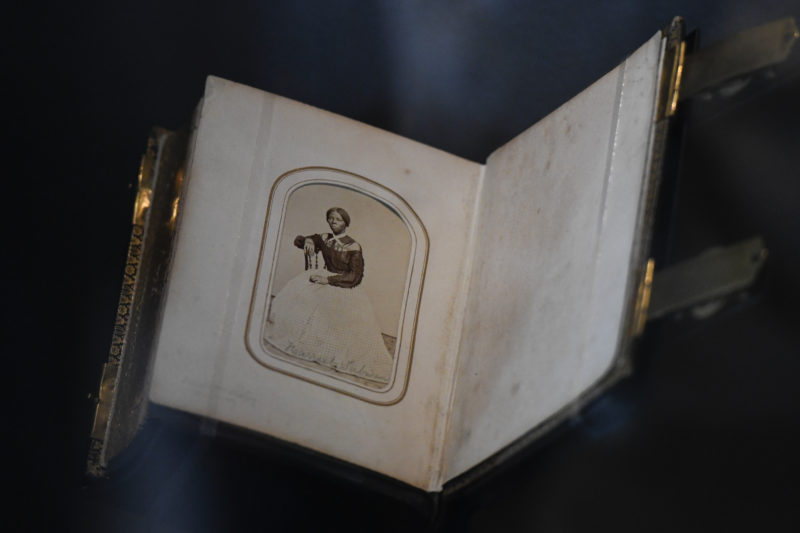
A previously unknown portrait, c. 1868, of abolitionist and Underground Railroad conductor Harriet Tubman is unveiled at The Smithsonian’s National Museum of African American History and Culture in Washington, on Monday, March 25, 2019. The photograph is believed to be the earliest photo of Tubman in existence. (AP Photo/Sait Serkan Gurbuz)
For her many trips transporting slaves to freedom along the Underground Railroad, historians have bestowed the title “Moses of her people” upon escaped slave, abolitionist, nurse and spy Harriet Tubman. But the images we’ve seen of Ms. Tubman in history books of an aging, frail and stern-faced woman, haven’t quite matched up to her legacy.
Now, a newly unveiled photograph of a younger Harriet Tubman gives new insight into the life of the legendary activist. Purchased at auction, the photo, included in an album along with four dozen other images of 19th century activists in the abolitionist movement, is now on display at the National Museum of African American History of Culture in Washington, D.C. NMAAHC and the Library of Congress, two years ago, pooled their resources to purchase the album, which unknown to the collector prior to the auction, featured a carte-de-viste photograph of Harriet Tubman taken in New York in 1868 or 1869.
“What this image does is give us a sense of a forty, forty-one-year-old Harriet Tubman. You can imagine how this woman could have led people through the swamps, this woman could have spied for the union, this woman could have demanded that America live up to its stated ideals. It really gives us a sense of a vibrant and active Harriet Tubman,” NMAAHC founding director Lonnie G. Bunch, III said Monday at the photo’s unveiling at the museum.
Video Courtesy of CBS 17
The photo showing Ms. Tubman seated, wearing a dress with a ruffled sleeve, her hair styled in a middle part, is typical post-Civil War portrait photography. “This photograph makes her human,” Bunch says. “She’s not the superstar. She’s not Moses. She’s not the great general. She’s a woman who did extraordinary things.”
Emily Howland, a feminist, abolitionist and schoolteacher who taught at Camp Todd, the Freedman’s School in Arlington, VA, was the original owner of the album. In addition to Ms. Tubman, the album contains circa 1860’s photographs of lesser-known, along with well-known activists, including Sen. Charles Sumner, abolitionist Lydia Maria Child and the only known photo of John Willis Menard, the first African American man elected to Congress.
“The pictures in this album show us the faces of activists and abolitionists, lesser-known figures, who now have their stories told,” Librarian of Congress Carla Hayden said, announcing that the photographs are now part of the public domain and available to view online, download and include in educational materials.
At least ten of the photos in the album were of teachers, some of whom were part of efforts to educate African Americans. “Emily Howland was a teacher and there are other teachers in this album—that shows you the importance of education. Teachers were change-makers as well,” Hayden said.
History book images of Ms. Tubman have thus far depicted her as a somewhat silent, solitary figure returning alone more than a dozen times to the South with few clues of her life beyond interactions with her co-conductors along the Underground Railroad. The photo gives new insight into her life as a free woman and her circle of influence.
“For me what I take away from it is the dress—there’s a stylishness to it,” Bunch said. “There’s a sense that Harriet Tubman is not this enslaved woman, beaten down but really somebody who said, ‘I deserve to be treated like a middle-class American woman and this image is one of my ways to demonstrate that.’”
Ms. Tubman’s is the final picture in the leather bound album of carte-de-viste photographs. Also known as CDV’s, these relatively inexpensive two-inch by four-inch photo cards became a popular option to take and share portraits. The positioning of Ms. Tubman’s photo in the album gives insight into how she was regarded among her peers, says Rhea Combs, NMAAHC curator of film and photography.
“When you think about the ecosystem of the people in this album, you can liken it to social media and who we have in our friendship circle.” [Howland] was able to demonstrate who her circle of friends were, and more importantly, the way that she’s placed Harriet Tubman at the end of that album, serves as a punctuation, as a period, as a real symbol of what I think Emily Howland’s life embodied,” says Combs. “It embodied something that was around freedom, social justice and equality for all. And no one better represents that and reflects that than Harriet Tubman.”
